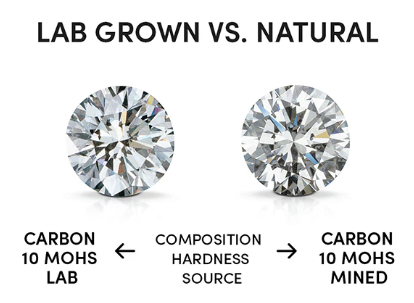FORGED UNDER UNIQUE CONDITIONS, A DIAMOND IS AN EVERLASTING EXPRESSION OF YOUR LOVE AND COMMITMENT

Grading Diamond Quality, The 4Cs
The 4Cs of diamond grading:
- Colour grade
- Clarity grade
- Cut grade
- Carat weight
Beautiful. Rare. Cherished. Each diamond is unique and is a miracle of time, place and change. Each diamond has specific, unique qualities that establish its value.
Until the middle of the twentieth century, there was no agreed-upon standard by which diamonds could be graded. The Gemological Institute of America (GIA) created the first, and now globally accepted standard for grading diamonds: Colour, Clarity, Cut and Carat Weight. Today, the 4Cs of Diamond Quality is the universal method for assessing the quality of any diamond, anywhere in the world.
The creation of the Diamond 4Cs meant two very important things – diamond quality could be communicated in a universal language, and diamond customers could now know exactly what they were about to purchase.
Natural Diamond Formation
Natural diamonds were formed within the Earth at 150 to 700 kilometres below the surface. Conditions of extremely high pressure and temperature produced pure crystallised carbon deposits in ‘diamond stability zones’ within the Earth’s fiery mantle. Diamonds are the hardest natural mineral, rated 10/10 on the Mohs Scale.
In rare geological events, deep-source volcanic eruptions of kimberlite magma delivered diamond deposits to the Earth’s crust. Access to naturally formed diamonds requires intensive mining processes. Extracted raw diamonds are cut and polished to unearth their true value.
Each is a unique creation.


Laboratory Grown Diamond Process
Laboratory Grown Diamonds are physically, visually, and chemically identical to their naturally formed counterparts.
Laboratory grown diamonds are created from tiny carbon seeds of pre-existing diamonds. Scientists use advanced technology – either extreme pressure and heat or a special process known as chemical vapour deposition – to mimic the method of natural diamond formation. Over the course of six to ten weeks, a rough diamond is formed. The stone is then cut and polished in the exact same way as a natural diamond.
As creator of the Diamond 4Cs and the International Diamond Grading System™, GIA is the global authority, and trusted source for unbiased assessment.
I am text block. Click edit button to change this text. Lorem ipsum dolor sit amet, consectetur adipiscing elit. Ut elit tellus, luctus nec ullamcorper mattis, pulvinar dapibus leo.
Man-Made Diamonds, Two Main Methods
There are two primary methods of producing man-made diamonds, and both use a small diamond seed to grow a large diamond crystal.
1. High Pressure High Temperature (HPHT)
This method mimics the conditions under which natural diamonds are formed inside the Earth. In controlled laboratory settings, a large machine is fed pure carbon material that is then crushed under 5-6 GigaPascals (GPa) of pressure and exposed to temperature extremes ranging from 1,300 to 1,600 degrees Celsius (°C). The carbon material dissolves, and carbon atoms deposit on the seed crystal to create a large diamond.
2. Chemical Vapor Deposition (CVD)
The CVD process involves placing a seed diamond in a small vacuum chamber filled with a heated mixture of hydrogen and carbon gasses. At temperatures of 700 to 1,200°C and 1-4 GPa of pressure, the gas molecules break down and layers of crystallised carbon form around the seed, growing a more substantial diamond.
Laboratory Grading Certificates
You can’t differentiate between Naturally formed diamonds, HPHT laboratory grown diamonds, and CVD laboratory cultivated diamonds with the naked eye. Only scientists can distinguish the differences by analysing and identifying markers caused by the growth conditions.
The grading criteria for mined and laboratory grown diamonds are identical, and both gemstones are sold with independent Laboratory Grading Certificates from reputable laboratories worldwide.
For more information on Diamond Grading, watch GIA’s video guide below – How to Choose a Diamond | A Tour of the 4Cs and the GIA Laboratory.
